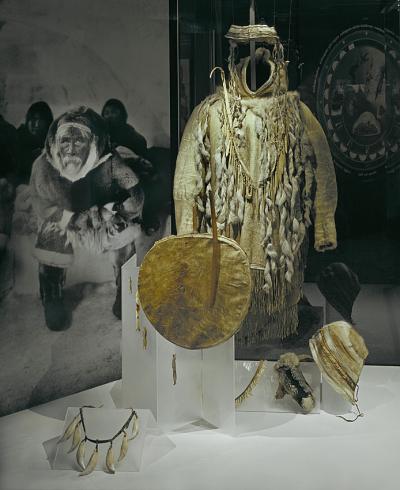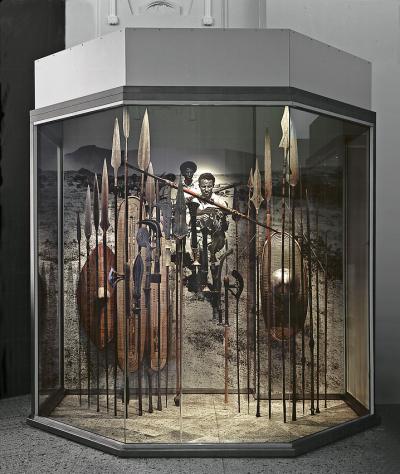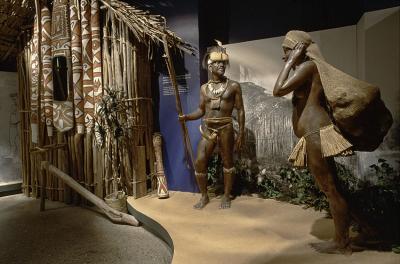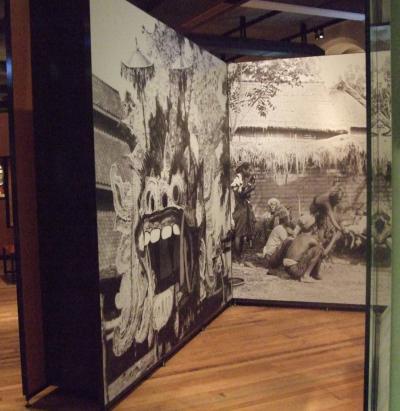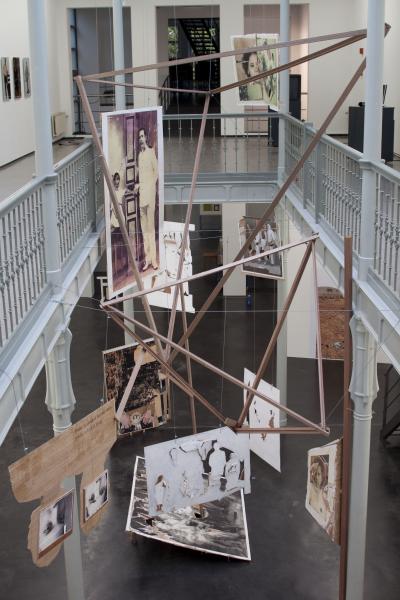Photography in the Museum Displays 2. The Work of Photographs
What is the work that photographs are put to in museums? Our research identified the following broad categories or framings which we found useful in thinking about the work of photographs in displays and the latter’s archival underpinnings: explanation, contextualization, affect, narrative, design solution, and reflectivity. The absence of photographs is also significant, for both for epistemological and political reasons. Such categories are not mutually exclusive and different categories can exist simultaneously within the gallery space. For example the category of ‘contextual use’ of photographs also sets up the category of affective responses. Neither can categories necessarily create stability; they cannot override the instability of photographic meaning in the museum space. We argue, nonetheless, that clarity of the purpose and framing of photographs in museum displays can facilitate a more engaged response from viewers.
Explanation: This is the most common category. Photographs are used as illustrations to ‘explain’ other classes of objects and to authenticate the subjects of exhibitions. As such they are used as unmediated windows on the world, purveyors of fact and of truth, and maintaining what Gaby Porter has described as an ‘economy of truth’ within the museum space.
Often in such uses photographs themselves are not historically positioned as objects or statements in their own right. This can contribute to a sense of timelessness. An example of this approach is in the Africa Gallery of the British Museum. Here small photographs are used, integrated in the text panels, with minimal documentation and explanation, to ‘show’ a mask being worn or a type of knife carried. Another example is the exhibition of the Arctic in The Museum of Cultural History, Oslo. Here photographs taken by the polar explorer Roald Amundsen over a hundred years ago demonstrate the displayed objects, clothing, weapons for hunting etc , in use.
Photographs are used to give context to a subject matter to a collection of objects. Overlapping with both ‘explanation’ and ‘affect’ photographs are used to give a broader sense of the historical context of displays. An example is in the Dutch Colonialism Gallery at the Tropen Museum where photographs are used extensively to ‘thicken’ up the understanding of objects and construct the contexts of colonial activity, from military action to education. Another example is the way some photographs are used in the exhibition Colonial Times in the University Museum of Bergen. The exhibition area was transformed into a ‘colonial harbour’ with sails and cargo. On the large sail canvases photographic images of boats and distant landscapes were projected.
However in many instances, the photograph seems marginalized from the main narrative, not expanding understanding of the object but mere authenticating it – this approach is exemplified in the Africa galleries at the British Museum, where the aesthetic approach uses photographs not merely to contextualise but authenticate the objects as genuinely African and traditional.
Photographs are used to create affect, to engage the emotions, and create a period and geographical ‘feel’. The Africa display in The Museum of Cultural History, Oslo, exemplifies this. In one of the display cases a montage of spears are shown in front of a large contemporary photograph of guerilla soldiers. Affect can take what might be described as ‘hard’ and ‘soft’ forms. The latter is often a sense of latent atmosphere. This can take the form of a group of people - photographs used literally to ‘people’ or inhabit a gallery on inanimate objects, a street scene and landscape in which a photograph is enlarged as a photographic mural, enhancing what Gaby Porter has described as the ‘economy of truth’ in the museum.[i] Such soft forms are quite rare in relation to colonial photographs because of curatorial fears that ‘soft’ affect appeals to a politically undesirable colonial nostalgia or even a glorification of the colonial enterprise.
Photographs used for what might be described as ‘hard’ affect often carry a key engagement with the collections, or in many cases the site that has been photographed. This strategy has been widely used in addressing difficult histories in museums and memorializing sites. For instance the massing of photographs at the Tuel Sleng Museum of Genocide Crimes in Cambodia not only commemorates victims, but suggests the enormity of the history being explored. The affect of the serried ranks of faces, brutalized and tortured, becomes an important mode through which to articulate the message of the museum. The wall of victims which characterizes displays in Holocaust museums and memorials adopts a similar strategy, using again the faces of victims to both individualise and stress the enormity of crimes against humanity. While these examples address genocidal histories, the same technique has been used in difficult histories with colonial strands. This is especially so in the case of migrant and diasporic museums, such as the Norwegian Emigrant Museum in Hamar, Indies Centre of Remembrance Museum, Bronbeek or Ellis Island Museum, New York. Often the individual photographs are relatively small, using scale to suggest the intimate, individual and humanizing, and inviting individual and affective rather than voyeuristic engagement from the viewer without loosing sight of the enormity of the histories involved though the act of massing photographs.
Narrative: Photographs as a narrative strategy can also be used to give density to specific part of a display. In the scenic, ‘tableaux vivantes’ displays that were so popular in the 1960’s and 1970’s, photographs blown up in format became a central part of the museum narrative. One example of this were the displays curated by the Norwegian anthropologist Fredrik Barth in The Museum of Cultural History, Oslo. In the Indies Centre of Remembrance Museum, Bronbeek and the British Empire and Commonwealth Museum, Bristol (now closed) photographs are used to move the narrative through the gallery space. Similarly photographs are used in the exhibitions Colonial Times and I permit myself to send you a bundle of Malagasy things in the University Museum of Bergen to structure the way the visitors move through the exhibition space. This approach is dependent on an engaged photographic thinking in the conception of exhibitions. At BECM the use of, usually, four photographs to a panel gave density to both text and objects and rather than illustrating the text the photographs were used to position the possibilities of alternative histories or histories beyond the frame of the museum itself. Photographs were also used to set up questions in the narrative, for instance in the use of a photograph from Tanganyika (Tanzania) in the 1930s, of a small European child being fed by an African man, a family servant. In the words of one of the curators this photograph “stopped visitors dead in their tracks, and really made them think about colonial relationships”. In Bronbeek, with few captions to showcases, the photographs are closely related to oral narratives about the emergence of a Dutch-Indies community in a colonial society. The many informal photographs on display stressed the notion of ‘personal’ histories connected to generic images of colonial society in the East, that resonate in Dutch society.
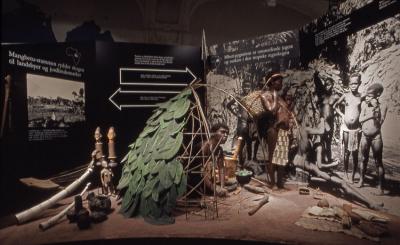
Design: Design plays an enormous role in the role of photographs in museum in general and in colonial narratives in particular. There are two forms. The first might be said to bring narrative and affect together as is the case at Bronbeek where the design and presentation of the photographs gives them a dedicated role. Photographs in large numbers are printed as collages in a wallpaper -like format. They use colour schemes - like red and black, grey and black, light blue and black - to separate the various exhibition parts and to reflect the nature of the specific section narratives. Thus the design solution which enmeshed photographs also served the exhibition narrative. However in other instances that we saw, photographs had been used to fill space, to frame the case and focus the viewer’s attention, or just to add colour, in ways that added nothing to the narrative of the exhibition. In such uses, photographs are often denied their own histories. For instance in the semi-permanent South East Asia Gallery at the Tropenmuseum enlargements of black and white photographs, both close the vista and give a sense of place and culture.
One of the challenges of photographs in the museum is the possibility of using them reflectively. A number of museums were including colonial images into broader critical spaces. For instance Assembling Bodies at Cambridge Museum of Archaeology and Anthropology in 2009 which explored the technologies, including photography through which bodies become known and become visible included anthropometric photographs – usually photographs seen as ‘too difficult’ to exhibit. Other examples of such critical uses of colonial photographs can be found in the I permit myself to send you a bundle of Malagasy things in the University Museum of Bergen. Here the photographs contribute to visualize and problematise a ‘colonial gaze’ in relation to collection history and missionaries as ethnographic collectors . Similarly the Sami Collections in Karasjok consciously re-appropriate colonial photographs in their touring exhibitions. Here they invite local people to participate in the reconstruction of their local history.
Another major reflective space through which the colonial might be explored was through contemporary arts practice, as for example in Naro Snackey’s installations around Indo-Dutch family albums and in the Sami Collections in Karasjo, In the latter, the exploration of colonial imagery is a central issue in the art works, particularly in the photography based art, represented in the museum space. While these strategies have been very popular in museums, at the same time we found some curatorial unease with the way that these works were understood by museum visitors. There was a sense that this was a strategy that worked for curators and artists, but not necessarily more broadly. It also raised the question to what extent were artists being used as the conscience of museums. None the less we found that artist interventions formed the most widespread strategy through which the photographs of the colonial past could be made visible yet contained. In effect, although such works offered a critical and reflective stance on both colonialism and its museal legacy, they simultaneously became a safe space through which the colonial could be made visible and discussed. For example Museum Volkenkunde Leiden, presented an exhibition Anceaux’s Glasses : Anthropological photography since 1860 (2002) which was a reflexive history of their photographic collections in physical and cultural anthropology. The project and exhibition included new commissions to artists like Roy Villevoy, Susan Meiselas, Diana Blok, Martin van den Oever and Nadine Salas . This is an example too of the growing trend for museums to commission or collect both photographic art work and documentary work in order to create new ways to present their historical collections. For instance Pitt Rivers Museum has purchased work from Dave Lewis and Bharti Parmar which constitute critiques of museums, anthropology and their colonial connections. The latter work hangs in the museum’s lecture theatre and, appropriately, presided over PhotoCLEC’s final symposium at the museum in January 2012.
Many artists are not using historical photographs directly but rather referencing them in their work, For example Gonkar Gyatso’s series ‘My Identity 1-4” (2003) acquired by Pitt Rivers Museum in 2005. The work was made in response to a photograph by colonial diplomat Sir Charles Bell which is in their collection. This is to be the approach in a body of work currently under commission at the Pitt Rivers Museum by Australian Aboriginal artist Christian MacDonald. This arguably marks a departure from the dichotomized readings of ‘the colonial archive;’ which has marked much of the work of this nature from the 1980s onwards, for instance that of Faisel Abdul Allah made for the Photographers Gallery as part their collaboration with the Royal Anthropological Institute The Impossible Science of Being in 1996, perhaps the absorption of that critical discourse by collections themselves.
Finally, in considering the categories of ‘work’ one must note the absence of photographs in museum displays and the ways in which absences might be significant. Absences occur both intentionally and incidentally. Some absences arose from a lack of clear policy. Some museums did not think ‘photographically’, their collections of photographs were often uncatalogued, perceived as marginal to the business of the museum and thus not called upon to ‘work’ in the institution. As one UK curator put it ‘they are just there’. Other absences are a matter of policy and institution agenda. For instance the Sainsbury Centre for Visual Arts, University of East Anglia, UK focuses on the aesthetic qualities of objects. In this context, the realist insistence of photographs would detract from this approach, adding other layers of meaning. Similarly, a national museum curator commented “we simply aren’t allowed to use photographs of faces in displays.” What these absences demonstrate are the hierarchies of objects in museums and the ambiguities in the assumed role of photographs, especially in colonial or cross-cultural histories.
In other cases absences were caused by a prevailing uncertainty about the ability to control the different meanings that photographs might make in the galleries. It was quite clear from interviews with many curators that photographs of the colonial past were seen as both too direct and destabilizing and too ambiguous. As one UK curator commented “one of the difficulties we have, that actually getting into that nuanced discussion of how that photograph has been staged or whatever, that I’m not going to be able to get into, I just haven’t got the space.” Consequently many curators chose to avoid photographs altogether.
The most significant absences are those around the politics of memory. Not only does a sense of absence resonate through all our research findings in the different museum engagements with the colonial past. This is a space that has also engaged a number of the artists engaging with the photographic legacy of the colonial past.
However, a powerful absence at the Sámi National Museum, Karasjok, Norway, goes to the heart of the structure of history itself. The museum resists using photographs on the walls of the museum in its permanent displays, specifically because the temporal insistence of photographs could run counter the museum’s attempt to present an alternative narrative of the historical, one which is not structured through dominant ways of structuring the past.
[i] Gaby Porter, “The Economy of Truth: Photography in the Museum” Ten-8, (1989) 34 : 20-33.
